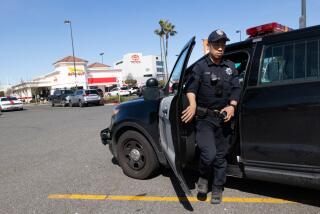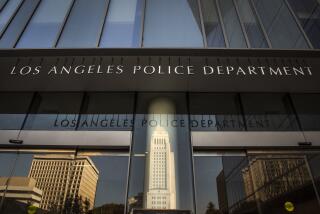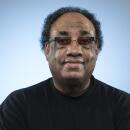Top Cops Pan TV Car Chase Coverage
Ratcheting up the pressure on TV news stations in a city transfixed by car chases, Los Angelesâ top law enforcement officials made a public appeal to media bosses Wednesday to reduce their coverage of police pursuits.
Flanked by Police Chief William J. Bratton and county Sheriff Lee Baca, Mayor James K. Hahn told a news conference that ceaseless coverage of local car chases is dangerous, and incites suspects to flee.
He said the broadcasts give incentive to âcareless individuals who want their 15 minutes of fame.â
News executives said their coverage of chases, which has become a staple of Southern California news broadcasts, is measured and responsible. None interviewed said they would agree to scale back the coverage in response to the appeal. Typically, car chases generate big ratings.
KTLA-TV Channel 5 News Director Jeff Wald -- whose station is owned by Tribune Co., which also owns The Times -- disputed a link between media coverage of police chases and the inclination of suspects to run.
âIn about 99% of these chases, we see the motorist taken into custody in a relatively orderly manner,â he said. âWe see this coverage as being more of a deterrent.â
The notion that TV coverage encourages flight was also greeted skeptically by John Doherty, a criminologist at Marist College in Poughkeepsie, N.Y. Suspects run, he said, not to get attention, but âto get away.â
They almost never accomplish that, said Richard Moran, professor of sociology and criminology at Mount Holyoke College in Massachusetts. More than 40% of chases in the United States end in accidents, he said, and 1% end in death -- most often to the fleeing driver. As a result, Moran said, viewers of car chases have a better than fair chance of seeing mayhem or bloodshed if they stick with it.
Thatâs why viewers should stop watching, said Rick Caruso, president of the Los Angeles Police Commission: People get hurt. Such concerns prompted the commission to restrict pursuits, instructing LAPD officers to no longer give chase for traffic infractions, a decision that is projected to cut pursuits by 60%.
At the news conference, local law enforcement leaders -- also including Mike Brown, chief of the California Highway Patrolâs Southern Division; and Torrance Police Chief James Herren -- asked the media to negotiate with them over chase coverage.
âWe are not trying to quell 1st Amendment rights,â Caruso said. âBut why not work with us? ... At least give it a test. A six-month blackout period.â
In addition to encouraging suspects, the broadcasts incite gawkers who go out to watch and may thereby put themselves in danger, Hahn said. Besides, he added, âwe think itâs kind of boring.â
Bratton appealed to the conscience of TV journalists: âYou know this isnât what your stations should be doing.â
In the past, some police agencies have taken a more lenient view of media coverage.
The Sheriffâs Department has maintained a contract since 1996 with a firm that markets police videotapes to reality-based TV shows. The department gets royalties -- about $9,000 a year -- for the tapes, of which only one has contained a pursuit, officials said.
Told of the contract Wednesday, Baca said he had been unaware of it and planned to discontinue the practice. The department shouldnât be commercializing crime, he said.
Chase coverage may have one benefit, said Mount Holyokeâs Moran, a policing expert: It may ensure that police donât rough up suspects after a pursuit. The notorious beating of Rodney G. King by LAPD officers in 1991, for example, came on the heels of a car chase.
And in the past, police in general were known to be purposely harsh with suspects after a chase to reinforce the idea that âyou are going to be sorry if you donât pull over,â Moran said.
LAPD Deputy Chief David Doan disagreed, saying police today âfeel watched no matter what.â
Local media executives expressed little inclination Wednesday to yield. Most said the coverage of police chases is a matter of public safety, especially when suspects drive on freeways and escape on foot.
Don Corsini, president and general manager of KCBS-TV Channel 2 and KCAL-TV Channel 9, said in a statement that, although he welcomes a dialogue with police, âour audience has made it clear they want us to report on the actions of local law enforcement personnel when public safety is endangered.â
Arnie Kleiner, president and general manager of KABC-TV Channel 7, said the station is already judicious in its coverage.
âIn his news conference, Mayor Hahn himself described chases as âlife and death situations,â â Kleiner said in a prepared statement. âA story that fits that description is generally worthy of live coverage.â
Some local news executives said privately that they resented that Bratton and the other participants had not met with them beforehand. The chief said he has raised the issue with news executives in the last few months.
According to LAPD statistics, the number of police pursuits grew steadily in the late 1990s to 782 in 2001, but fell to 643 in 2002, even before the new restrictions on pursuits were enacted. About 36% of LAPD pursuits resulted in accidents over the last two years, department statistics show.
Police pursuits have been controversial, and some, such as the pursuit of celebrity murder suspect O.J. Simpson, are part of local folklore.
More recently, police chases have made the news in a different way -- in the form of high-profile pedestrian injuries and deaths.
More to Read
Sign up for Essential California
The most important California stories and recommendations in your inbox every morning.
You may occasionally receive promotional content from the Los Angeles Times.











